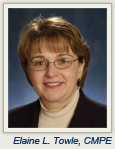Would it surprise you to learn that 40% of your peers in oncology who responded to a survey last year have a certified electronic medical record system in place? Or that 86% of them are in physician-owned practices? Or that the average number of full-time equivalent hematology/oncology physicians in oncology practices is 7.9?
After digesting your copy of National Practice Benchmark, 2011 Report on 2010 Data, none of these metrics will surprise you. A supplement to the November issue of the Journal of Oncology Practice (JOP), the report contains the results from the only national benchmarking survey that focuses on the specialty of oncology, showing practices’ answers to questions such as: What pressures are impacting your business decisions? How are your drugs purchased or procured? How many staff members do you have, and what are their jobs?
New Metrics to Come Out Each Fall
 The new National Practice Benchmark supplement—which will be in your hands soon—officially kicks off the supplement’s annual status with JOP; going forward, each year a new report will be published along with a fall issue of JOP, providing a handy account of exactly how your peers are handling various sectors of their business, and giving you a tool to help manage your own practice.
The new National Practice Benchmark supplement—which will be in your hands soon—officially kicks off the supplement’s annual status with JOP; going forward, each year a new report will be published along with a fall issue of JOP, providing a handy account of exactly how your peers are handling various sectors of their business, and giving you a tool to help manage your own practice.
Benchmarking is widely recognized as the most efficient way to look for opportunities to improve your practice and then monitor progress after corrective action is taken, said Thomas R. Barr, MBA, founder and General Manager of the Oncology Metrics division of Altos Solutions, which has for 6 years distributed the survey, analyzed the data collected, and published a report summarizing the findings.
Statistics You Can Use
 “This is for folks interested in looking at the big picture and comparing what’s going on in their practice to what’s going on in other practices,” said Mr. Barr. “It’s a reference that practice administrators and managing physicians find useful in their assortment of tools used internally to improve their own operations.”
“This is for folks interested in looking at the big picture and comparing what’s going on in their practice to what’s going on in other practices,” said Mr. Barr. “It’s a reference that practice administrators and managing physicians find useful in their assortment of tools used internally to improve their own operations.”
This year’s survey was returned by 117 practices in 37 states. The report’s author, Elaine L. Towle, CMPE, who had 25 years of experience in oncology practice management before joining Oncology Metrics as Director of Consulting Services, remarked that the benchmarks for revenue, expenses, and staffing are of particular interest year after year. This year for the first time, Oncology Metrics also asked practices for specifics about spending on information technology.
“We’ve known for several years that the impact of information technology on oncology practices is growing, but like most things, it creeps in slowly,” added Mr. Barr. “Now, with meaningful-use objectives from the federal government requiring a certified electronic medical record, we recognize that this is a full-blown cost department. So we asked, what is your cost to maintain the technology and its connectivity?”
Practices Identify Current Challenges
 Another new question this year, said Ms. Towle, centered on business challenges. Survey respondents were asked to rank the pressures that are currently affecting their business decisions. Interestingly, she said, it was virtually a dead heat between (1) competitive pressures (market competition); (2) cost pressures (drug costs, rent, staff costs, physician compensation, general operating costs); and (3) payer pressures (declining reimbursement rates, contracting, preauthorization/precertification requirements, retrospective denials, audits).
Another new question this year, said Ms. Towle, centered on business challenges. Survey respondents were asked to rank the pressures that are currently affecting their business decisions. Interestingly, she said, it was virtually a dead heat between (1) competitive pressures (market competition); (2) cost pressures (drug costs, rent, staff costs, physician compensation, general operating costs); and (3) payer pressures (declining reimbursement rates, contracting, preauthorization/precertification requirements, retrospective denials, audits).
Given the current milieu of lower reimbursement, buyouts by hospitals, uncertainty about the future of Medicare, and general economic uneasiness, Ms. Towle said it was also a little surprising that many of the respondents said they expected their current business structure to remain unchanged and viable for at least the next 5 years.
“That contradicts what we hear all the time and see in the marketplace, which is that the current practice model that’s out there can’t continue to exist,” said Ms. Towle.
Look for your copy of the National Practice Benchmark with your November issue of JOP. ■
© 2011. American Society of Clinical Oncology. All rights reserved.

